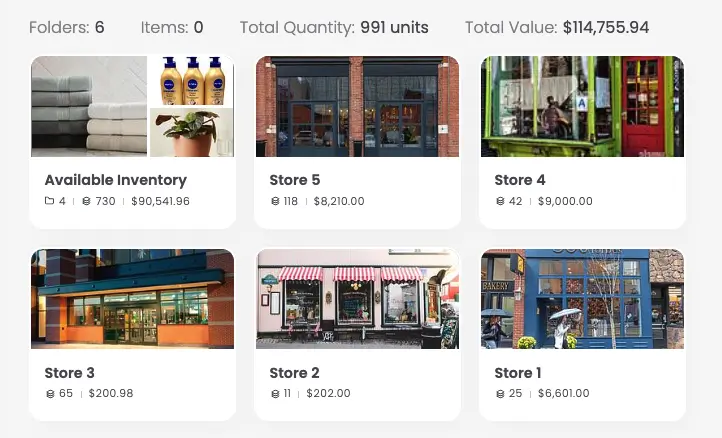Managing inventory across multiple locations—whether that’s a single off-site storage unit or dozens of warehouse locations—can be a logistical challenge. Without a centralized inventory management system, businesses risk stockouts, overstocking, and costly discrepancies that disrupt the supply chain.
This guide explores the challenges of multi location inventory management, how to align your strategy with your business needs, and seven best practices to streamline operations, improve inventory control, and drive customer satisfaction.
Challenges of multi-location inventory management
Even well-run operations face hurdles when inventory is spread across various locations. Here are four common challenges that arise when managing inventory across multiple locations:
1. Difficulty communicating between different locations and departments
When teams operate in different time zones or manage inventory independently, communication breakdowns are inevitable. Without shared visibility and standardized operating procedures, it’s nearly impossible to maintain accurate inventory records across sites.
2. Inaccurate data
Manual updates, outdated spreadsheets, and inconsistent tracking methods lead to unreliable inventory data. This affects everything from replenishment to demand forecasting and can result in excess inventory or stockouts.
3. Inconsistent inventory standards
Without standardized processes, each location may count, label, and audit inventory differently. This makes it difficult to reconcile inventory levels or compare performance across sites.
4. Lack of a centralized, synchronized system
Without a unified inventory solution, businesses struggle to track inventory movement, identify shrinkage, and respond to demand in real time. A centralized inventory management system is essential for visibility and control.
This easy, comprehensive guide will help you:
Free Ebook: Getting Started With Inventory Tracking
Match your multi-site inventory model to business needs
Before implementing new tools or workflows, ensure your inventory strategy aligns with your operational structure. Here’s how:
Compare centralized vs. decentralized control models
Centralized models offer tighter control and consistency. Decentralized models allow for more autonomy at each site. Choose the system that will work for you based on your team size, product mix, and supply chain complexity. Since you know how your business runs and how unique each site is, let individual locations operate independently if it optimizes performance.
Align per-site forecasting with product mix and demand patterns
Each location may serve different customer segments or use different inventory, supplies, and assets. Tailor forecasting methods to reflect local demand and seasonal trends. Inventory management software that tracks consumption over time and by location helps immensely by making data collection far easier.
Design workflows for cross-location transfers
Inventory often moves between sites. Create systems and invest in solutions that support transfers, track item history, and prevent double-counting or loss. Keep in mind that this will likely take refining; no standard operating procedure is built or perfected on day one.

7 multi-location inventory management best practices
These seven best practices can help your business take control of inventory across multiple locations:
1. Pick a system that’s built to handle multiple sites
Choose inventory management software designed for multi-site tracking. While spreadsheets may work for small operations, they’re prone to error and lack real-time inventory visibility.
Sortly’s cloud-based platform allows each location to manage inventory independently while syncing data across all locations. Features like folder-based organization, barcode and QR code scanning, location-based reporting, and return-to-origin capabilities make it easy to track inventory across multiple job sites.
2. Standardize processes, naming conventions, and SOPs across locations
Consistency is key. Establish universal naming conventions, units of measure, and inventory workflows. Sortly supports this with customizable fields, tags, and folders—making standardization less manual and more scalable.
3. Train employees and have them create inventory lists for each site
Equip each team with the tools and training they need to succeed. With Sortly, employees can scan items, upload photos, and add notes—creating detailed, searchable inventory records with minimal effort.
4. Use location-based reports to inform decisions
Accurate inventory data enables smarter decisions. Use location-specific reports to forecast demand, identify slow-moving items, and plan purchases. Sortly’s reporting tools include visuals, item history, and barcode data for deeper insights.
5. Optimize reordering based on inventory data
Set reorder points and low stock alerts to prevent stockouts. With Sortly, you can automate alerts and even generate purchase orders directly from your inventory dashboard. This saves time and improves accuracy.
6. Learn how to search your inventory database at any time to locate products
A searchable inventory system is essential. Sortly’s intuitive search and filtering tools let employees locate items instantly. This reduces downtime and improves collaboration across sites.
7. Perform regular inventory audits
Regular audits help catch discrepancies and improve data hygiene. This ensures your records match reality, giving you reliable numbers for accurate forecasting, budgeting, and purchasing.

How to measure the success of your multi-location inventory management approach
Tracking performance metrics is key to continuous improvement when it comes to managing inventory in multiple locations. Here’s how to measure the success of your strategy:
Track forecast accuracy
Compare projected demand to actual usage. Adjust forecasting models based on location-specific trends.
Track stock variance and reconciliation speed by location
Measure how quickly and accurately each site reconciles inventory. High variance may signal process issues or data gaps.
Monitor and audit
Use audit results to identify patterns, retrain staff, and refine SOPs. The immediate goal is not perfection, but progress. Use your data to refine processes, improve accuracy, and scale confidently.
Scale multi-location inventory management with Sortly
Sortly helps businesses of all sizes organize and track inventory across multiple warehouses, storage locations, offices, or job sites. Our solution comes equipped with smart features to help you manage inventory with ease, whether you have one location or one hundred. For example:
- Custom folders for location-based tracking
- Barcode and QR code scanning right from the app
- Low stock alerts so you always know what and when to re-order for each location
- Customizable user permissions to give the right level of access
- Location-based reporting for a clear view of inventory data at each site
You’ve seen the challenges of managing multi-site inventory, but it doesn’t have to be a headache. Sortly makes inventory simple, scalable, and genuinely stress-free—so you can stop worrying about your inventory and start focusing on growth. Ready to put the complexity behind you? Start your two-week free trial of Sortly today.




